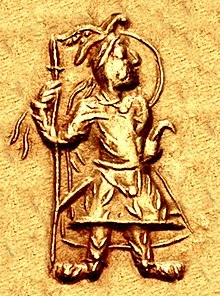| Verethragna | |
|---|---|
 |
| Part of a series on |
| Zoroastrianism |
|---|
 |
|
|
Verethragna or Bahram (Avestan: 𐬬𐬆𐬭𐬆𐬚𐬭𐬀𐬖𐬥𐬀, romanized: vərəθraγna) is a Zoroastrian deity.[3][4]
The neuter noun verethragna is related to Avestan verethra, 'obstacle' and verethragnan, 'victorious'.[5] Representing this concept is the divinity Verethragna, who is the hypostasis of "victory", and "as a giver of victory Verethragna plainly enjoyed the greatest popularity of old."[6] In Zoroastrian Middle Persian, Verethragna became 𐭥𐭫𐭧𐭫𐭠𐭭 Warahrām, from which Vahram, Vehram, Bahram, Behram and other variants derive.
The Proto-Aryan adjective *vrtraghan, which corresponds to the Avestan noun Verethragna, also has an etymological cognate in Vedic Sanskrit - Vrtra. In Vedic literature, Vrtrahan is predominantly an epithet used for Indra[7] after he defeated Vrtra. Vrtrahan literally means "slayer of Vrtra."
The name and, to some extent, the deity was borrowed into Armenian Վահագն Vahagn and Վռամ Vṙam, and has cognates in Buddhist Sogdian 𐫇𐫢𐫄𐫗 wšɣn w(i)šaɣn, Manichaen Parthian 𐭅𐭓𐭉𐭇𐭓𐭌 wryḥrm Wahrām, Kushan Bactrian ορλαγνο Orlagno.[8] While the figure of Verethragna is highly complex, parallels have also been drawn between, Puranic Vishnu, Manichaean Adamas, Chaldean / Babylonian Nergal, Egyptian Horus, Hellenic Ares and Heracles.
- ^ Fleming, Benjamin; Mann, Richard (26 March 2014). Material Culture and Asian Religions: Text, Image, Object. Routledge. p. 433. ISBN 978-1-135-01372-1.
- ^ Stewart, Sarah; Williams, Alan; Hintze, Almut (16 February 2016). The Zoroastrian Flame: Exploring Religion, History and Tradition. Bloomsbury Publishing. p. 184. ISBN 978-0-85772-815-9.
- ^ Kuehn, Sara (12 July 2011). The Dragon in Medieval East Christian and Islamic Art. BRILL. p. 103. ISBN 978-90-04-18663-7.
With a foreword by Robert Hillenbrand
- ^ Fragner, Bert G. (30 September – 4 October 1991). "[no title cited]". Proceedings of the Second European Conference of Iranian Studies: Held in Bamberg, 30th September to 4th October 1991, by the Societas Iranologica Europaea. Istituto italiano per il Medio ed Estremo Oriente (published 1995).
- ^ Gnoli (1989), p. 510.
- ^ Boyce (1975), p. 63.
- ^ Thieme 1960.
- ^ "Orlagno". British Museum (britishmuseum.org).